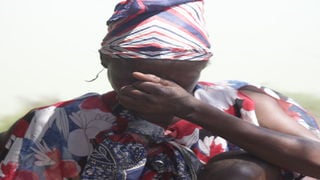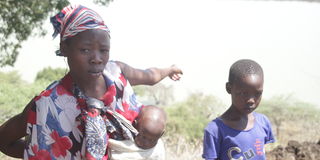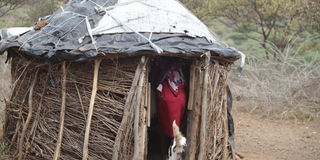
The mother of the missing girl, Toyoi Lokodong, overwhelmed with emotions, told Nation.Africa that she has been having sleepless nights, expressing hopes that one day the remains will be found.
| Florah Koech | Nation Media GroupBaringo
Premium
The blessing and curse of Lake Baringo
When 11-year-old Cherop Samut left school for home on August 8 this year, she was in high spirits, even promising her headteacher that she would be the first to resume learning the following day.
The Grade Two pupil at Katuit Primary School on the border of Baringo North and Tiaty sub-counties had just completed her day’s classes at 1pm and was released together with her lower primary counterparts.
It is reported that the girl thereafter, with two of her friends, went to wash clothes and take a bath at the adjacent Lake Baringo, just a few metres from their school.
It is here that she was attacked by a crocodile, which dragged the helpless girl into the flooded lake.
The other girls tried to pull her from the jaws of the fierce reptile but they were overpowered, prompting them to raise the alarm. Villagers responded and started searching for the girl.
Kenya Wildlife Services (KWS) officers in the Ruko conservancy and locals camped at the lake for four days but her body or remains were not found.
It has been three months of pain and anguish for the family of David Samut, who lost their firstborn daughter. Worse still, they did not find the remains to bury so as to get some closure.
The mother of the missing girl, Toyoi Lokodong, overwhelmed with emotions, told Nation.Africa that she has been having sleepless nights, expressing hopes that one day the remains will be found.
“It is so sad that three months later, the remains of my firstborn daughter are yet to be retrieved. Every day I camp on the shores of the lake with hopes that I could even spot part of her body,” the mother of three said amid sobs.
Baringo County KWS deputy warden David Cheruiyot said they searched for the missing body for more than a month but were unsuccessful.
“When we received the report of the attack, we went to the area and our officers, other stakeholders and locals mounted a search for the missing girl. The search continued for a month but we did not find the remains,” Mr Cheruiyot said.
Such cases of human-wildlife conflict have been on the rise at the lake owing to the drastic rise in water levels that has led to wildlife, including crocodiles and hippos, moving closer to people’s homes.
The lake, the only source of water for locals, is a blessing and a curse in equal measure. Many of the casualties of such attacks are children who go there to fetch water or wash clothes unattended.
Cherop is the latest victim among dozens of children who have been mauled to death by crocodiles and hippos while washing clothes, herding animals or fetching water. Others are nursing serious injuries or permanent disabilities.

Toyoi Lokodong, the distraught mother of Cherop Samir, 11, from Katuit in Tiaty who was mauled by a crocodile on August 8, 2021 at the shores of Lake Baringo while washing clothes with her peers.The body of the minor is yet to be retrieved three months later.
Last year, a 10-year-old boy was killed by a crocodile in Ng’enyin village on the shores of the lake.
The Class Three pupil had gone to water his grandfather’s goats one Thursday afternoon. When he tried to quench his own thirst, he was attacked by the beast.
Joshua Kipsobut, the boy’s grandfather, said he had instructed his grandson to go and look after the goats near the lake, a normal practice among locals. He received reports in the evening that the boy had been attacked by a crocodile.
Fighting back tears
“I am very pained with the loss of my grandson because he died a painful death after being attacked by a crocodile. We searched for his body for more than two days only to find it mutilated and headless,” Mr Kipsobut said, fighting back tears.
In November last year, three children from Meisori village in Baringo South were attacked by a crocodile in the lake.
The incident happened as the trio - Sabatto Tiren, 10, Kemboi Tuna 12, and Maureen Tuna, 14 - were fetching water for domestic use at the Lake Baringo airstrip when one of them was attacked.
Samuel Tiren, an uncle of one of the children, said the other two tried to rescue their victim but they were also attacked by the animal.
He noted that one of the children suffered multiple injuries in the right shoulder, hip and stomach while the others were wounded in the leg and hand respectively.
“They were rushed to Marigat Sub-County Hospital while the 10-year-old boy who was seriously wounded was taken to Baringo County Referral Hospital,” Mr Tiren said.
Baringo County KWS warden Peter Lekeren urged locals to be careful “because attacks by animals in the area have increased”.
In 2019, a 10-year-old boy from Kampi Samaki was also mauled by a hippo while fetching water from the lake.
Lake Baringo warden Jackson Komen attributed the rising wildlife attacks in the area to the drastic increase in the lake’s water levels.
The lake level, he said, had increased from 236km square in 2015 to about 270km square now.
“The lake has now moved closer to villages, and wildlife are roaming closer to people’s homesteads. Hippos and crocodiles move out of the water to bask and in the process prey on livestock that come to drink or, worse still, kill people,” Mr Komen said.
Last year alone, he said, they received reports of 10 people killed by crocodiles around the lake.
Compensate 50 families
He cautioned locals and teachers in schools bordering the lake to stop sending children to fetch water or wash clothes unaccompanied.

Baringo County KWS deputy warden David Cheruiyot said they searched for the missing body for more than a month but were unsuccessful.
He also said KWS had teamed with the county government and Geothermal Development Company, which is prospecting in the area, to set up water tanks and kiosks to supply water from the lake to villages.
In June this year, the government spent more than Sh29.7 million in the first phase to compensate 50 families affected by human-wildlife conflicts in Baringo County.
The money was issued at an event attended by Tourism CS Najib Balala at Kampi Samaki in Baringo North.
The government used the event to announce that Sh2 billion in compensation had been authorised for deaths and destruction of crops by wild animals from 2013 to 2017, highlighting the state of the conflict.
In the 2020/21 fiscal year, the State has set aside Sh523 million to compensate more than 4,090 victims and Sh600 million in the 2021/22 financial year.
“We spent more than Sh2 billion on compensation for human-wildlife conflicts from 2013 to 2017, and we still need another Sh3.1 billion that has not been budgeted yet,” Mr Balala said at the time.
He urged victims of human-wildlife conflicts to follow the required process by filing documents to avoid being locked out of the compensation process.
PS Fred Segor said that whereas compensation for human-wildlife conflict is good policy, the focus should be on adopting proactive measures to guard against clashes that result in the destruction of property, including crops and livestock, and loss of human life.
“My assurance to the communities is that everything possible is being done to guard against invasion by wildlife,” he said.
Governor Stanley Kiptis urged officials to expedite the compensation process, noting that many affected families had been impoverished by hospital bills.
He said his administration had set aside Sh16 million to upgrade the Lake Baringo snake park. This, he said, will support research and the milking of venom in partnership with KWS and Kemri to treat snake bites, which is common in the area.
About 200 to 300 snake bites are recorded in the arid and semi-arid areas per month, with a third of the victims succumbing to bites.
The situation is worse in dry spells, with snakes straying into homesteads in search of water.
Mr Cheruiyot, the KWS deputy warden, said venomous snakes in the region include cobra, puff adder and black mamba.
He said that in 2017, for instance, more than four deaths and 13 injuries were reported from snake bites while four deaths and 55 injuries were recorded in 2018.
The lowland areas where snake bites are common include Barwessa, Poi, Mugurin, Maji Moto, Bartabwa, Salawa, Endao, Lake Baringo, Kokwo, Maoi, Kapkuikui, Mukutani, Kiserian, Arabal, Marigat, Ng’ambo, Salabani and Ilng’arua.
According to the World Health Organization (WHO) Neglected Tropical Diseases list, an estimated 5.4 million people are bitten by snakes every year, with close to 2.7 million by venomous snakes.
More than 100,000 people have died from snake bites and 400,000 more left with life-long disfigurement and disability.





